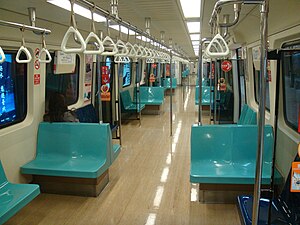Taipei Metro C301
| Taipei Metro EMU301 | |
|---|---|
 A Taipei Metro C301 on the Tamsui Line. | |
 Interior of the motor car of a C301 train | |
| In service | March 28, 1997-present |
| Manufacturer | Union Rail Car Partnership 1992-1994 |
| Number built | 132 vehicles (22 sets) |
| Formation | 3 x 2-cars per trainset |
| Capacity | 1914 passengers |
| Operators | Taipei Rapid Transit Corporation |
| Lines served | Tamsui Line, Xindian Line, Zhonghe Line |
| Specifications | |
| Car length | 23.5 m (77 ft) |
| Width | 3.2 m (10 ft) |
| Height | 3.6 m (12 ft) |
| Maximum speed | Design: 90 km/h (56 mph) Service: 80 km/h (50 mph) |
| Weight | 39.5 t (DM1/M2) 34 t (T) |
| Traction system | GTO-VVVF (Westinghouse Electric) |
| Electric system(s) | 750 V DC 3rd rail |
| Safety system(s) | ATS, ATC (ATO) |
| Track gauge | 1,435 mm (4 ft 8+1⁄2 in) standard gauge |
The Taipei Metro EMU301 cars are the first electric multiple units to operate on the heavy-capacity lines of the Taipei Rapid Transit System when the Tamsui Line began operations on March 28, 1997. A total of 22 trainsets were built from 1992 to 1994 by the Union Rail Car (URC) Partnership, a Japanese-backed consortium in America, at a cost of US$170 million.[1][2][3]
Production of the cars were done at the 150,000-square-foot (14,000 m2) Yonkers Plant,[4] which was well known as formerly owned by Otis Elevator Company where it first built elevators since the company's formation, and the first elevator factory in the world.[2][5] The factory is now under the Union Rail Car Partnership, consisting of Kawasaki Rail Car, Nissho Iwai American, and North American Transit.[4] They were the first cars in the Plant to be built for export, and the largest in the United States for over twenty years. Over half of the C301's components were made in America, as part of the Buy American Act requirements.[4] The GTO-VVVF propulsion system is supplied by Westinghouse and can supply up to 200 horsepower.

The interior of the EMU301 contains seats in both linear and latitudinal formation. A quarter of them are designated as priority seats. Fireproofing materials allow the train to withstand any fire for up to 45 minutes. Wheelchair spaces are provided for at the start and end of the cars. LED In-train information system is installed which displays the destination and line colour on the exterior, train announcements and next station information in the interior.
Trainset 013/014 was formerly split and modified to serve as 3-car formations to serve on the Xinbeitou Branch Line. When new EMU371 built in specialised 3-car formations were delivered to Taipei Metro, trainset 013/014 was subsequently rejoined and put back into normal service on the other lines.
Serial Number


Each individual car is assigned a four-digit serial number, which range from x001 to x044, where x depends on the carriage type.
- The first digit depends on whether the car is the first, second, or third car from either end of the train, where the first car equals 1, the second car equals 2, and the third car equals 3.
- The other three digits form the train's identification number. A full-length train of six cars consists of two identification numbers, one for the first three cars, and the other the same number plus 1 for the other three, where the smaller number is always an odd number. For example, a train of six cars would have serial numbers 1001, 2001, 3001, 3002, 2002, 1002 respectively
See also
References
- ^ 川崎重工業時代1969年(昭和44年), Kawasaki Heavy Industries, retrieved 6 April 2008 Template:Ja
- ^ a b Rail Car Plant In Yonkers Seeks $1 Billion Contract, The New York Times, James Feron, 17 January 1988
- ^ Yonkers plant produces first Taipei cars - Union Rail Car Partnership gets $170 million contract - Brief Article, Railway Age, October 1992
- ^ a b c Made in the U.S. - and Japan - Japanese-owned Union Rail Corp. assembles rail cars in the US with Japanese shells, William C. Vantuono, Railway Age, July 1993
- ^ THE REGION; Mayor of Yonkers Joins Otis Protest, Associated Press (The New York Times), 11 December 1982
